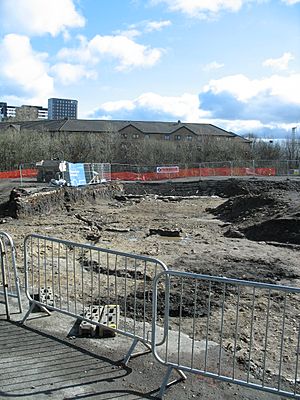Partick Castle facts for kids
Partick Castle was a historic building located in Partick, which is now a western part of Glasgow. It was built in 1611 for a kind man named George Hutcheson from Glasgow. The castle stood on the west bank of the River Kelvin.
Contents
What Was Partick Castle Like?
How It Looked and What Happened to It
In the early 1700s, a writer named Hamilton of Wishaw described Partick Castle. He said it was a well-built and comfortable house. It had many trees and large gardens surrounded by stone walls. The castle used to belong to George Hutcheson.
A local historian, James Napier, wrote about the castle's later years. He said it was left empty around 1770. By 1783, its roof was gone, and it was falling apart. The castle was completely taken down in the 1830s. Another local story says its remains were removed in just one night. They were used to build walls in nearby fields around 1836 or 1837.
Napier also shared a story from someone who had visited the castle when people still lived there. The lowest floor was partly underground and had arched ceilings. The second floor had a stone floor and several rooms. These rooms were like a guesthouse. The top floor had a wooden floor and a big hall. This hall was used for public meetings, dances, and parties. Above this floor were attic rooms for sleeping or storage. There was also a well outside the house. The main entrance door and an outer gate were covered with large nails. Stone walls surrounded the castle grounds.
A poem from the 1800s described the castle as lonely and sad. It stood where the Clyde and Kelvin rivers met. Long grass grew over its walls. The only sounds heard were distant waterfalls, where children played.
Today, the castle's remains are probably under the southwestern part of the Tesco store in Partick. This area used to be a scrapyard. Before that, it was a dyeworks, a foundry, and a laundry. Unlike most of old Partick village, the castle site was not destroyed. It was preserved under these industrial buildings. Recently, during work for Scottish Water, parts of the castle were found and dug up by archaeologists.
The Bishop's Old Home
Some people believe that George Hutcheson's castle was built on the site of an even older castle. This older castle was a country home for the Bishops of Glasgow. You can see this castle on the old coat of arms for the area of Partick.
In 1136, King David gave the land of Partick to the church leaders of Glasgow. In 1362, a disagreement between the Bishop and his church was settled at his "manor-house of Perthic." Glasgow's Bishops continued to use their home in Partick until 1560. This was during the Reformation, a time of big changes in the church. Bishop James Beaton II fled to France from Partick. He took important religious items from Glasgow Cathedral with him. The remains of this older castle might have been found in 2016. This happened near the mouth of the River Kelvin during work to install sewage pipes.
Later, in 1600, King James VI promised Sir George Elphinstone a bigger house. Sir George was given the New Park of Partick. His job was to manage the woods, bring in deer, and build a large house for himself and for the king to use after hunting. This house might have been built on the site of the Bishop's old residence.
An Even Older Royal Spot?
There is some evidence that Partick was an important place for the kings of Alt Clut/Strathclyde. This was a kingdom from the Dark Ages. A monk named Jocelin of Furness wrote that King Rhydderch had a home in 'Pertnech' (Partick).
Some archaeologists think that the royal estate in Partick was part of a larger important area for the kingdom. This area also included a church center across the River Clyde in Govan. The lands of Partick stayed royal property until King David gave them to the Bishops of Glasgow.
It's important to know that there is no direct proof. We don't know for sure if Hutcheson's castle was built on the exact same spot as this ancient royal home.


